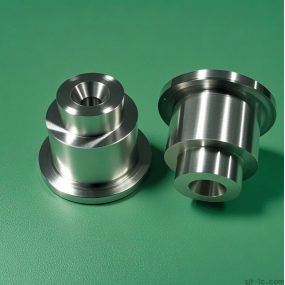Stainless steel machining refers to the use of mechanical processing equipment such as CNC machine tools, milling machines, and drilling machines to process stainless steel materials in order to obtain parts of the desired shape and size. Stainless steel machining needs to pay attention to the following points: 1. Tool selection: Stainless steel materials have high hardness, toughness, and wear resistance, so suitable tools need to be selected for machining. Generally speaking, stainless steel machining requires the use of hard alloy cutting tools or high-performance ceramic cutting tools.  2. Coolant selection: Stainless steel materials are prone to high temperatures during processing, so coolant is needed to reduce the temperature and prevent workpiece deformation or cracking. Common cooling fluids include cutting oil, emulsion, etc. 3. Selection of cutting parameters: The selection of cutting parameters for stainless steel machining is crucial for machining quality and efficiency. The parameters such as cutting speed, feed rate, and cutting depth need to be reasonably selected based on the performance of the machine tool and cutting tool, as well as the material and shape of the workpiece. 4. Processing sequence and clamping method: The processing sequence and clamping method of stainless steel machining also have a significant impact on processing quality and efficiency. It is necessary to choose the appropriate clamping method and processing sequence according to the material, shape, and processing requirements of the workpiece to ensure the accuracy and processing efficiency of the workpiece. 5. Surface treatment: The surface of stainless steel after machining usually needs to be treated to obtain the desired appearance and quality. Common surface treatment methods include polishing, wire drawing, sandblasting, etc.
2. Coolant selection: Stainless steel materials are prone to high temperatures during processing, so coolant is needed to reduce the temperature and prevent workpiece deformation or cracking. Common cooling fluids include cutting oil, emulsion, etc. 3. Selection of cutting parameters: The selection of cutting parameters for stainless steel machining is crucial for machining quality and efficiency. The parameters such as cutting speed, feed rate, and cutting depth need to be reasonably selected based on the performance of the machine tool and cutting tool, as well as the material and shape of the workpiece. 4. Processing sequence and clamping method: The processing sequence and clamping method of stainless steel machining also have a significant impact on processing quality and efficiency. It is necessary to choose the appropriate clamping method and processing sequence according to the material, shape, and processing requirements of the workpiece to ensure the accuracy and processing efficiency of the workpiece. 5. Surface treatment: The surface of stainless steel after machining usually needs to be treated to obtain the desired appearance and quality. Common surface treatment methods include polishing, wire drawing, sandblasting, etc.
Hello! Welcome to EMAR's website!
 English
English » »
» »
 Spanish
Spanish Arabic
Arabic French
French Portuguese
Portuguese Belarusian
Belarusian Japanese
Japanese Russian
Russian Malay
Malay Icelandic
Icelandic Bulgarian
Bulgarian Azerbaijani
Azerbaijani Estonian
Estonian Irish
Irish Polish
Polish Persian
Persian Boolean
Boolean Danish
Danish German
German Filipino
Filipino Finnish
Finnish Korean
Korean Dutch
Dutch Galician
Galician Catalan
Catalan Czech
Czech Croatian
Croatian Latin
Latin Latvian
Latvian Romanian
Romanian Maltese
Maltese Macedonian
Macedonian Norwegian
Norwegian Swedish
Swedish Serbian
Serbian Slovak
Slovak Slovenian
Slovenian Swahili
Swahili Thai
Thai Turkish
Turkish Welsh
Welsh Urdu
Urdu Ukrainian
Ukrainian Greek
Greek Hungarian
Hungarian Italian
Italian Yiddish
Yiddish Indonesian
Indonesian Vietnamese
Vietnamese Haitian Creole
Haitian Creole Spanish Basque
Spanish Basque












